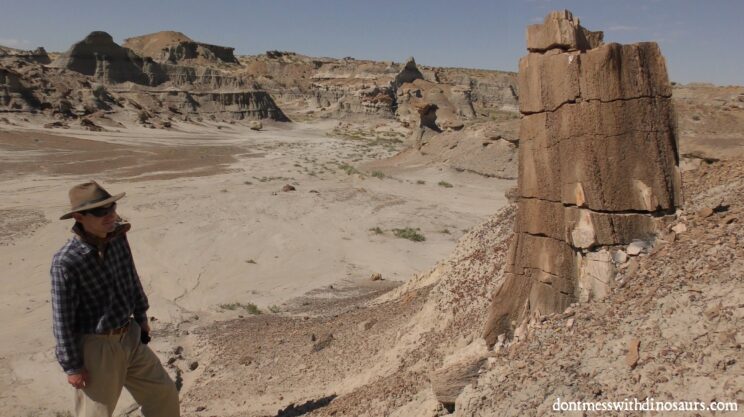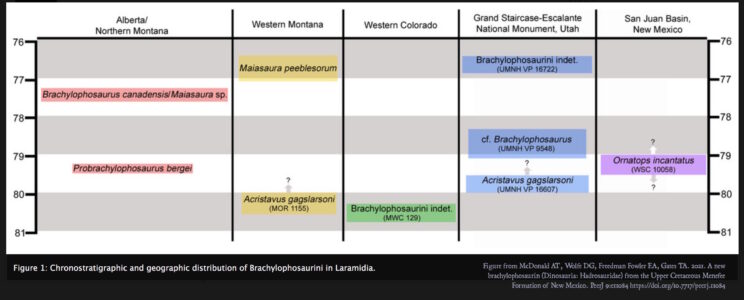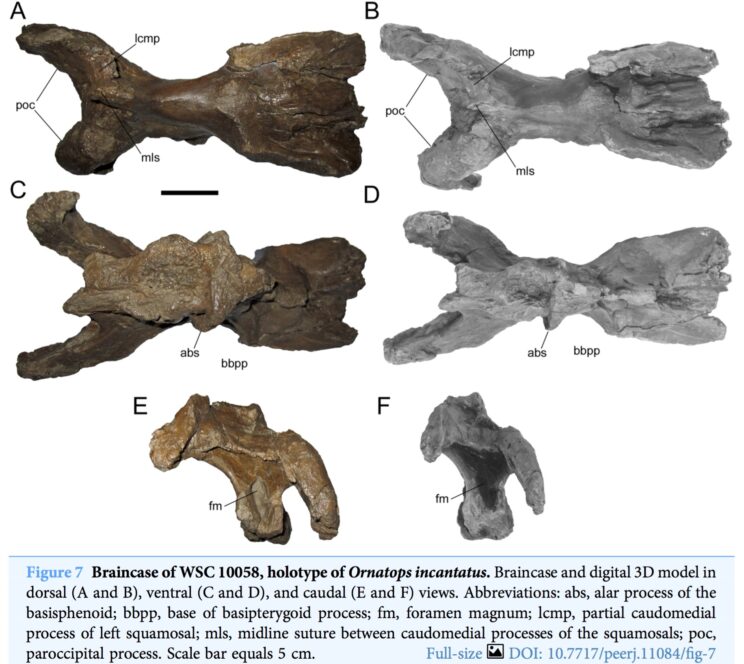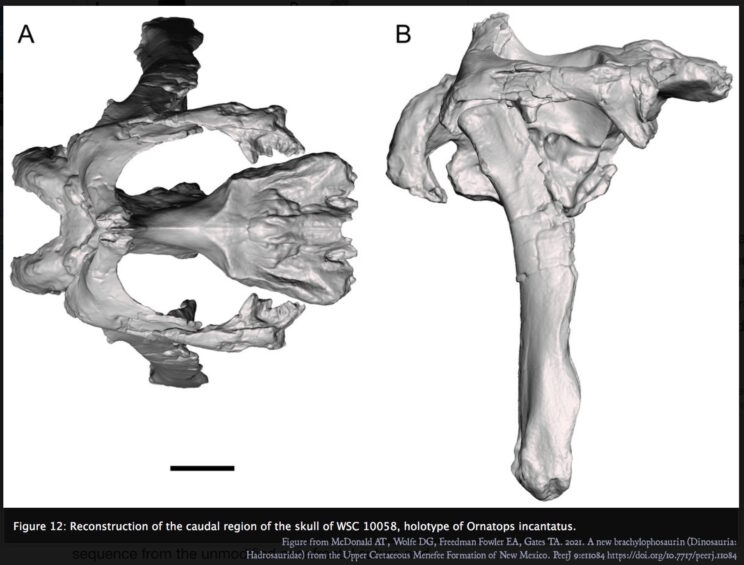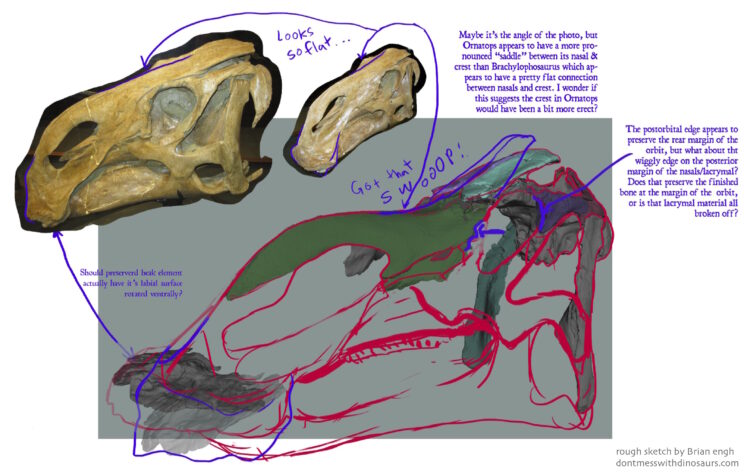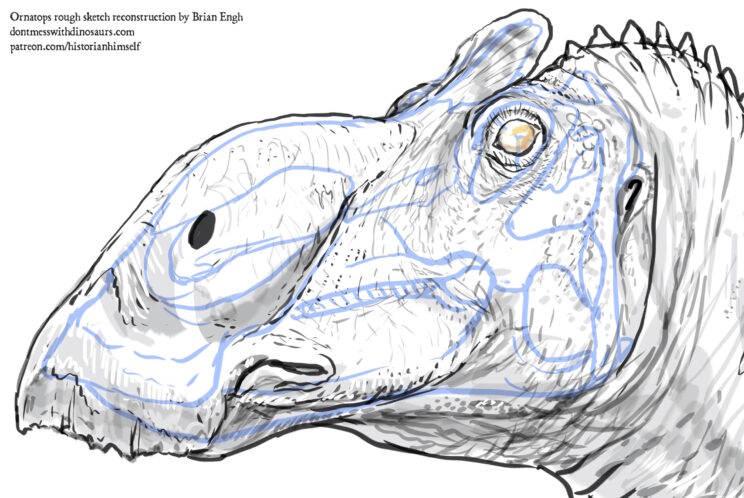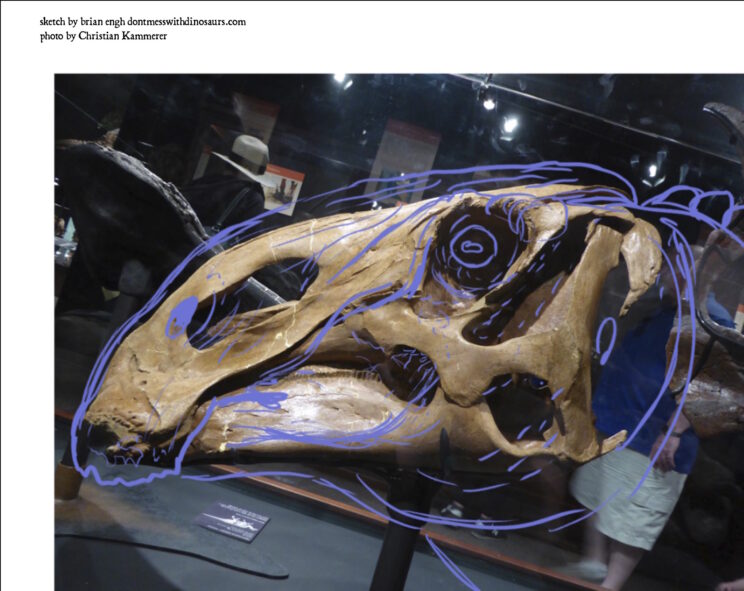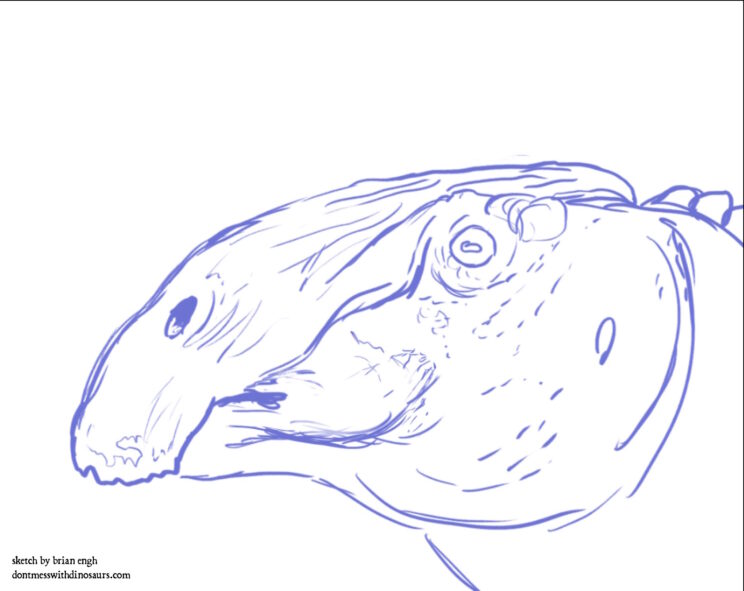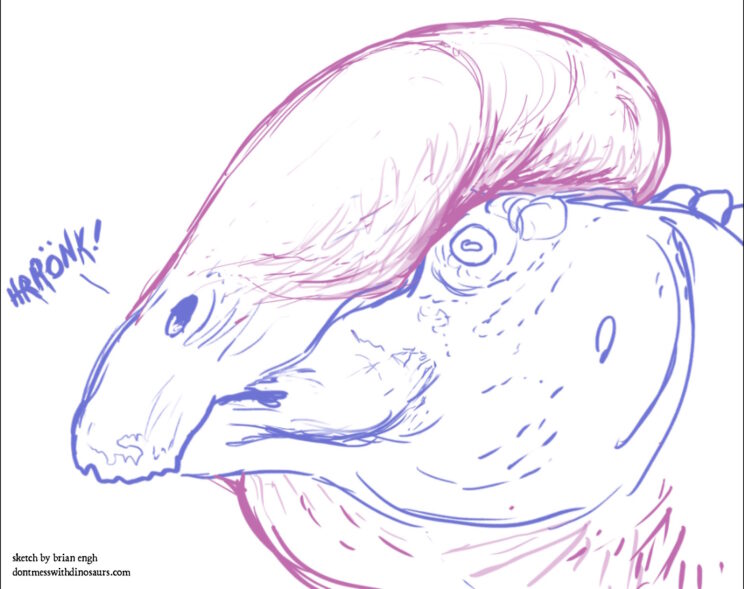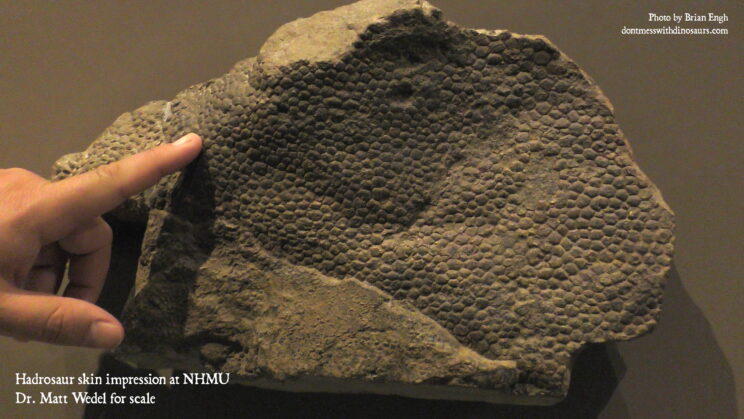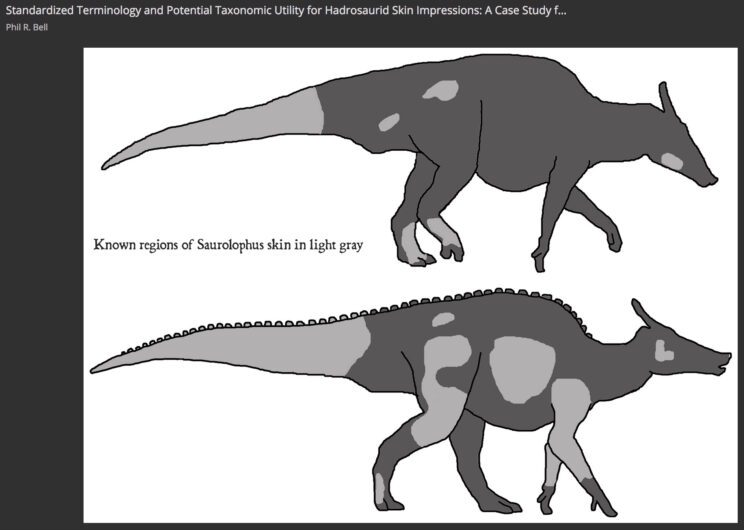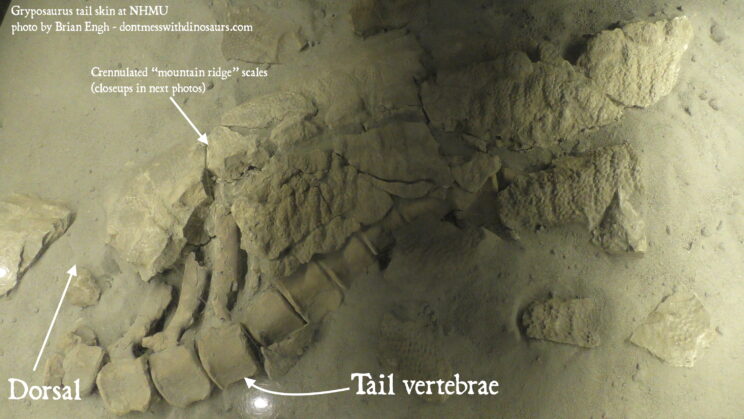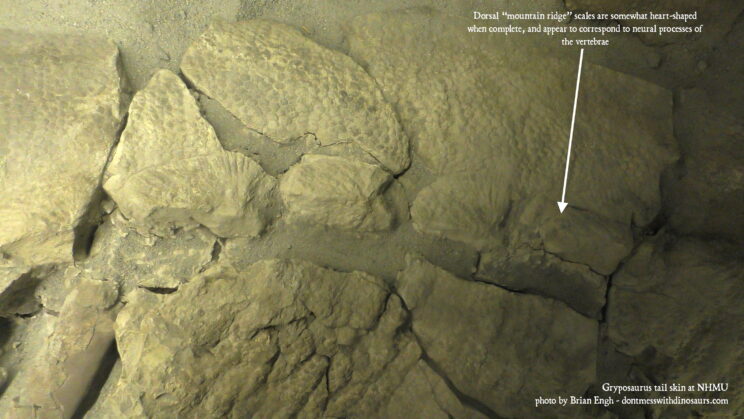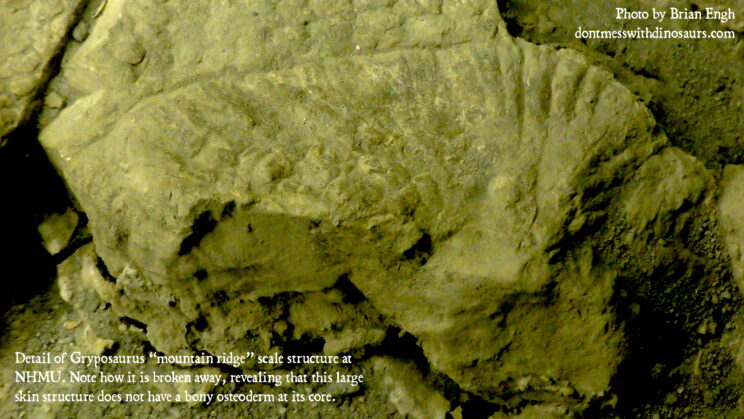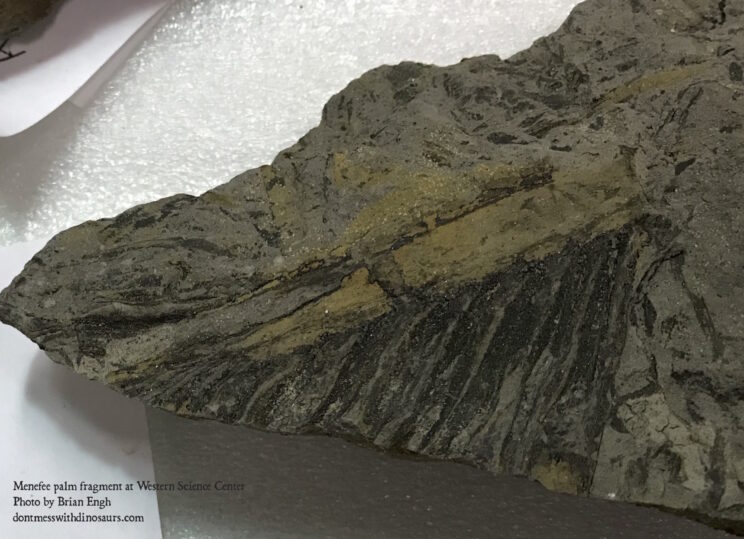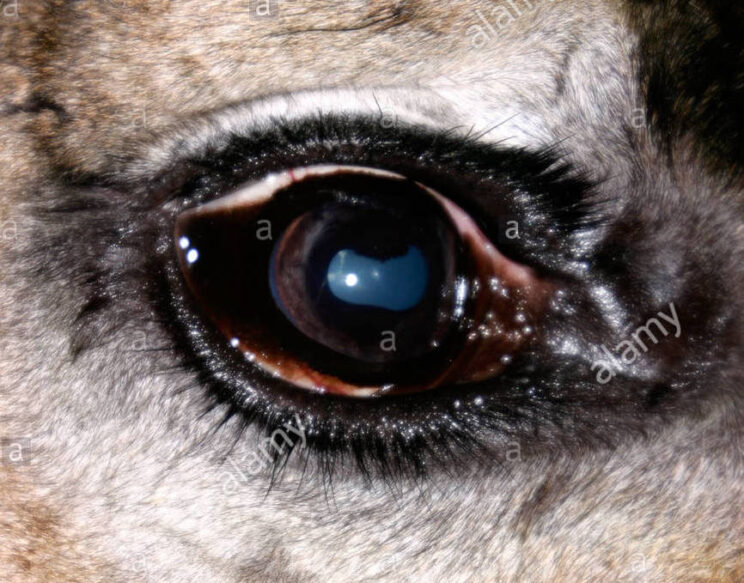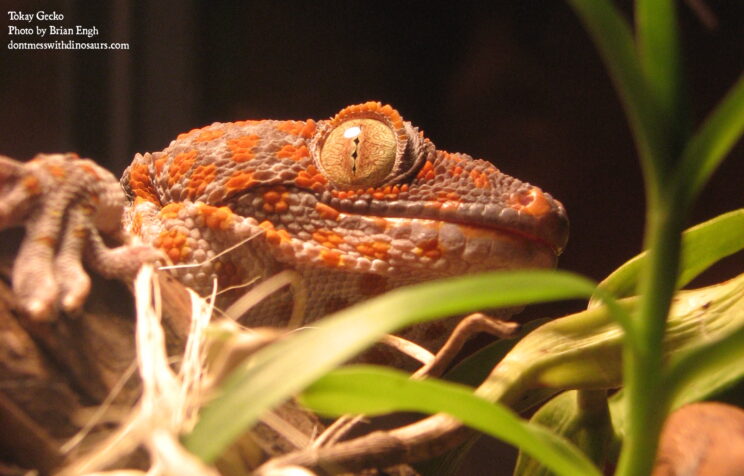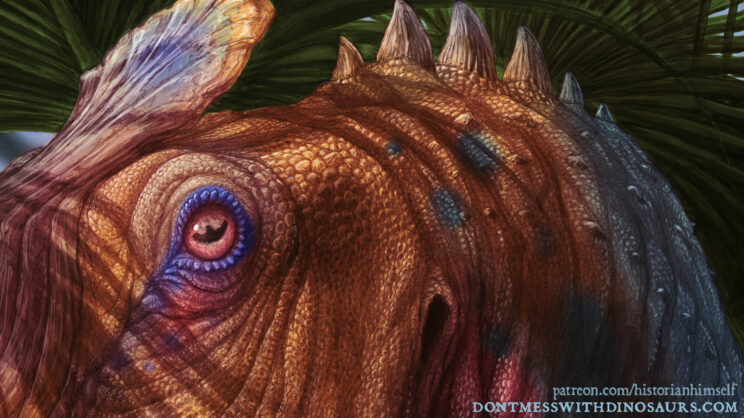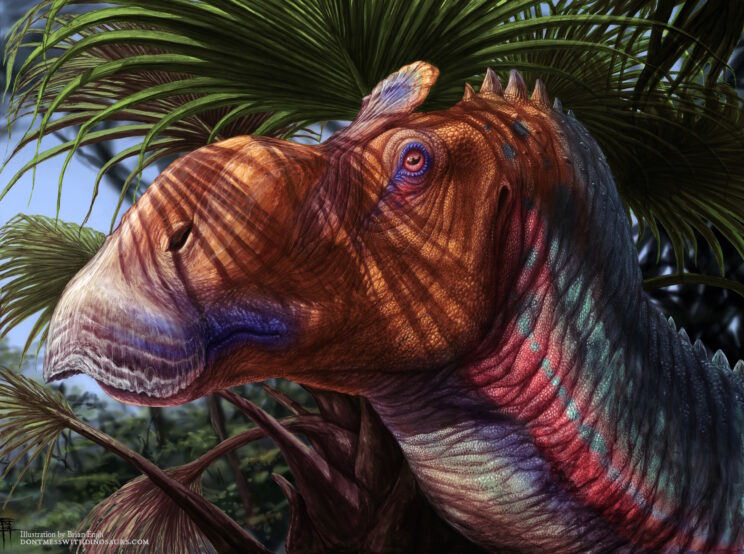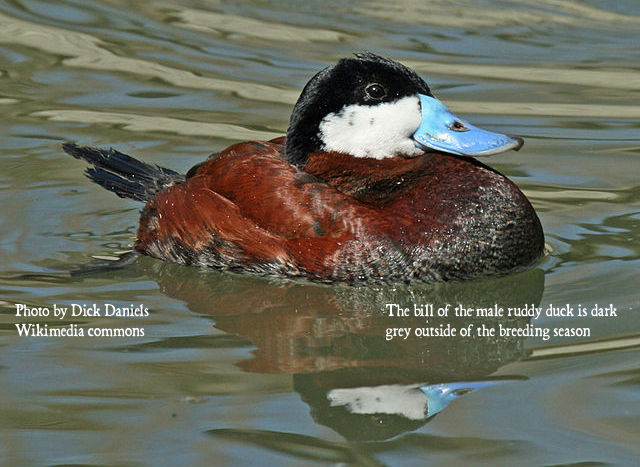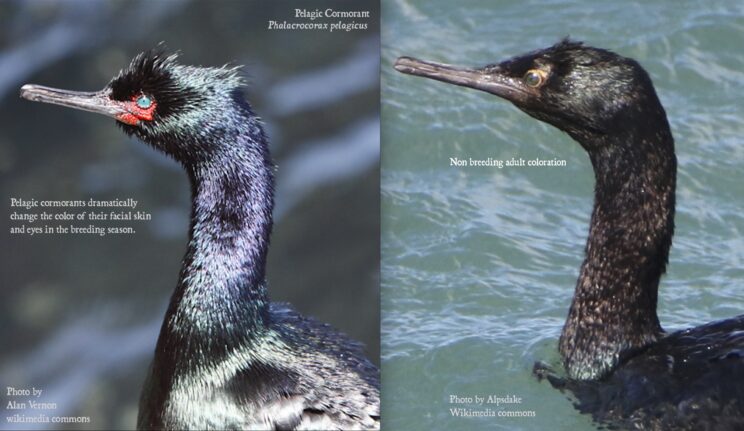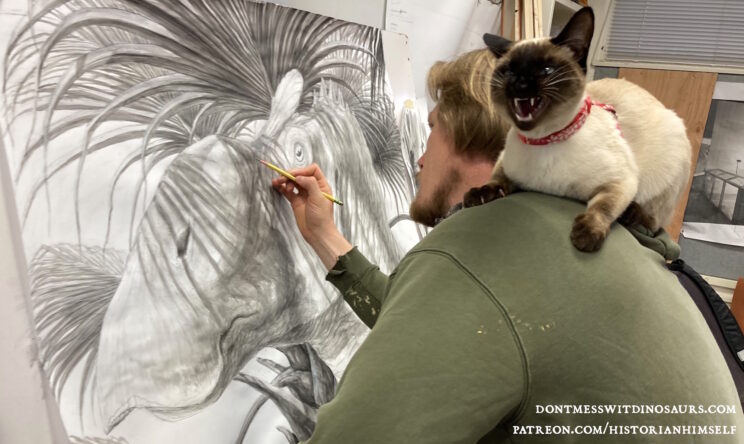Reconstructing the new Brachylophosaur Ornatops incantatus
Introducing Ornatops incantatus, a new Brachylophosaur from Upper Cretaceous New Mexico
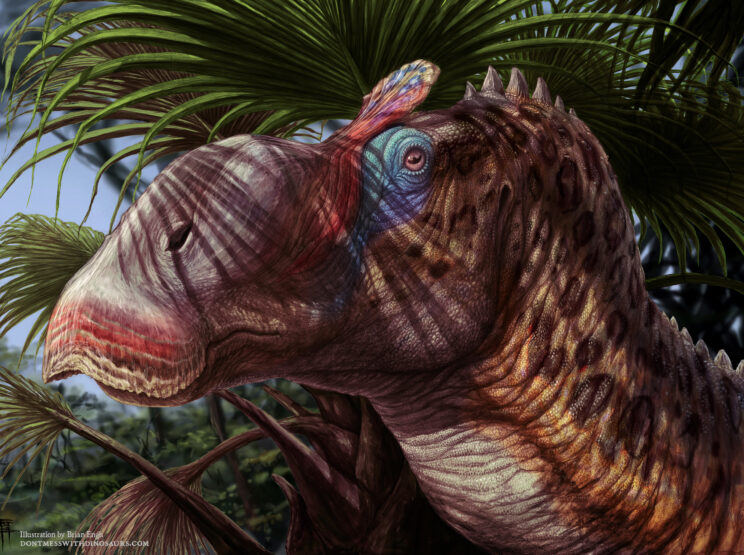
For the full open access scientific paper describing this new hadrosaur, click here:
A new brachylophosaurin (Dinosauria: Hadrosauridae) from the Upper Cretaceous Menefee Formation of New Mexico
My latest exhibit project in collaboration with the Western Science Center in Hemet California will be an exploration of the Upper Cretaceous Menefee Formation, slated to open later in 2021. This illustration of Ornatops is the first in a series of paleoart pieces that will populate the exhibit space.
Western Science Center’s Curator Dr. Andrew McDonald has been working hard for the last decade in collaboration with Zuni Dinosaur Institute for Geosciences and Southwest Paleontological Society to explore exposures of the Menefee Formation in New Mexico under permits from the U.S. Buraeu of Land Management. Turns out there are tons of fossils, and those fossils are helping to fill in a gap in the evolution of Late Cretaceous dinosaurs and the ecologies they lived in, because the Menefee Formation lies in time and space between several other important Upper Cretaceous fossil-bearing formations in Western North America
Ornatops is the third new dinosaur published from the Menefee formation, which has also yielded the early large Tyrannosaur Dynamoterror dynastes and the armored dinosaur Invictarx zephyri.
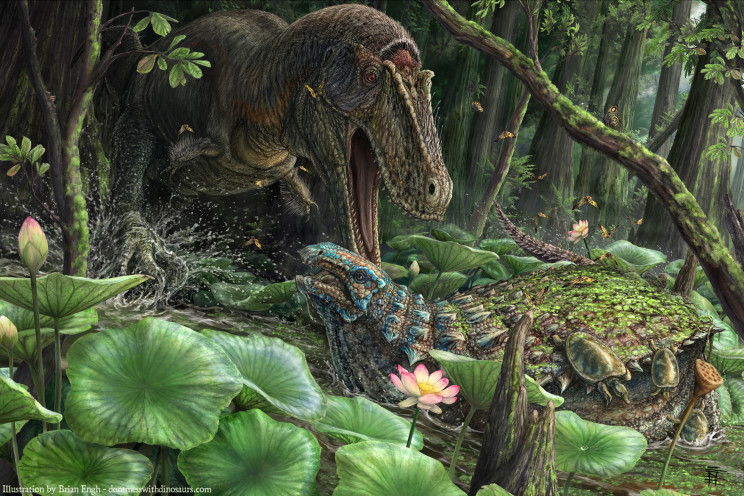
While Ornatops may look on the outside a lot like Brachylophosaurus the major differences are on the inside. Dr. McDonald and his team recovered the brain case of Ornatops, which is where the animal is truly ornate – with a number of distinct features – such as well-preserved nerve openings – that separate it from Brachylophosaurus and other closely related saurolophine hadrosaurs.
Fortunately for me, as a paleoartist, the major features missing from Ornatops’ skull can be filled in with a high degree of confidence from its close relative Brachylophosaurus, so the first step in reconstructing it was to become more familiar with the skulls of Brachylophosaurus and create a skull reconstruction based on those skulls in combination with this 3D model of Ornatops’ known skull elements, which was put together by WSC Museum Director Dr. Alton Dooley in collaboration with Dr. McDonald.
One of the features that stood out to me in this process of looking at the fossils and sketching was that the attachment for Ornatops’ crest ramped upward more steeply than the base of Brachylophosaurus’ crest, and on further discussion we concluded that this likely meant that Ornatops’ crest should be depicted as standing a little more erect than Brachylophosaurus, which is a cool little feature that differentiates the two even on the outside.
But what should Ornatops’ or Brachylophosaurus’ crest look like from the outside? While the exact shape of Ornatops’ crest is unknown, it likely supported a crest similar to that of its close relative Brachylophosaurus, which sports a low flattened crest that looks to me a bit like an inverted version of a dog’s tongue, with a ridge in the middle and two depressions on either side of that ridge. This got me wondering if the preserved bony crest of Brachylophosaurus might just be the bony base of a larger soft-tissue crest formed by the cartilage or other soft tissues of an expanded nasal capsule – meaning the cartilage and other soft tissues that surround the nose of many animals, including modern birds, crocodiles and non-bird dinosaurs.
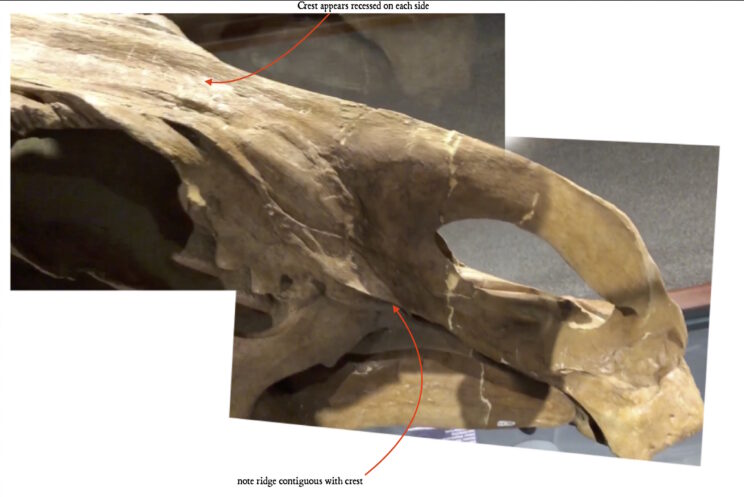
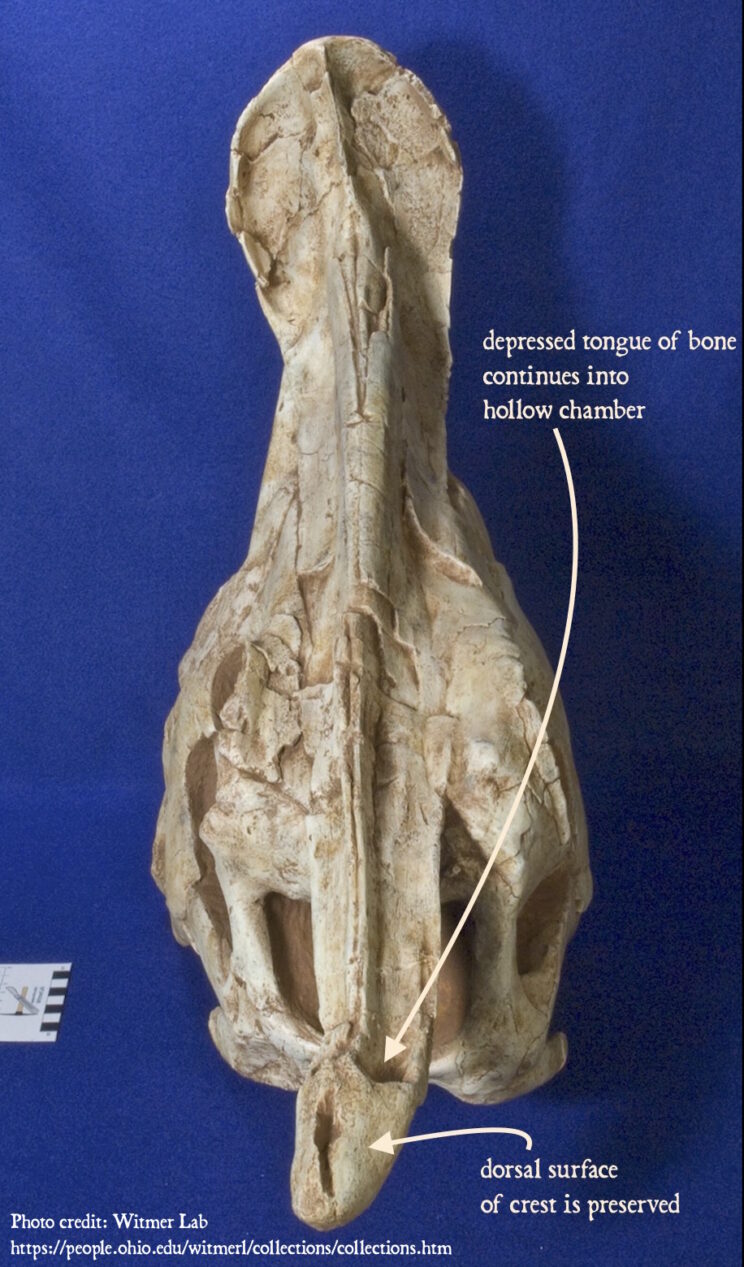
Such an interpretation has has been inferred for more derived saurolophine hadrosaurs such as Saurolophus and Augustynolophus, so I made this quick scribble to suggest the idea for our reconstruction.
While it’s a fun soft tissue interpretation, it’s not well supported at this time by the available fossil evidence, and Dr. McDonald explained to me that in Brachylophosaurus there isn’t a clear depression behind the bony opening of the nose which would indicate a significant expansion of that nasal capsule cartilage. That depression is referred to as the “circumnarial fossa” and in saurolophines with much more developed crests, such as Saurolophus, that depression is well defined and can be easily seen running up nearly the full length of their crests.
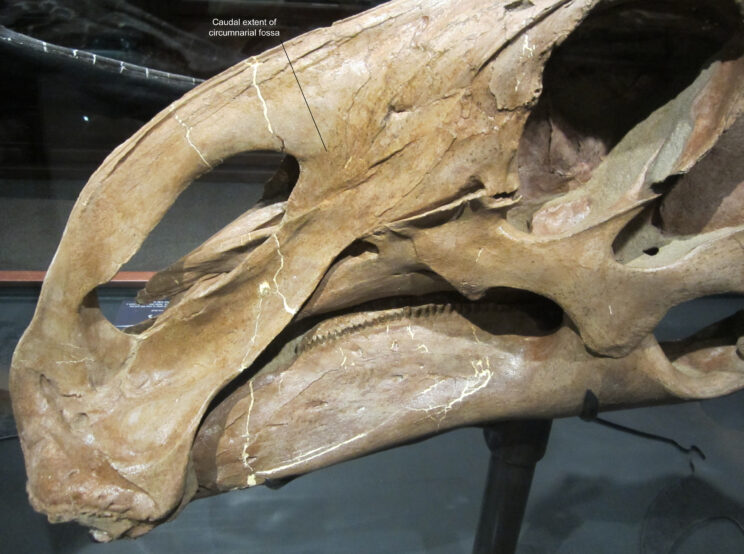
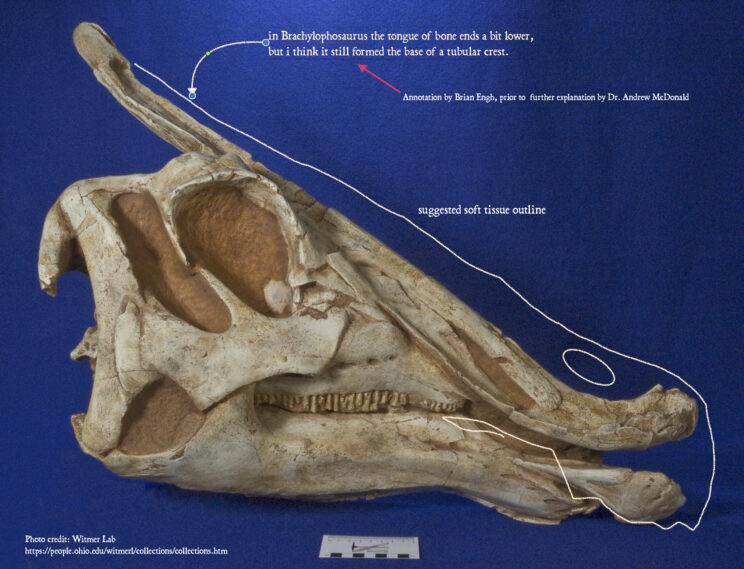
One of the features of saurolophin soft tissue we can be pretty confident about is the skin texture, as a huge array of skin impressions and even “mummies” (skeletons with associated mineralized soft tissues) are known from a bunch of hadrosaurs, including Ornatops’ close relatives Saurolophus, Gryposaurus and Brachylophosaurus.
All of these hadrosaurs are covered with a basement of small hexagonal scales, but each species seems to be somewhat uniquely decorated with enlarged tubercle scales and big scales of various shapes running down the midline along their spine. This incredible Gryposaurus fossil on display at the Natural History Museum of Utah the enlarged scale structures along the midline look really cool, with a heart-shaped footprint, and ridges that remind me of the erosional channels running down the sides of mountains or fossil-bearing desert badlands!
This Gryposaurus, like Leonardo the Brachylophosaurus also preserves a wonderfully big, rumply section of neck skin.
Once I had the base skeletal anatomy and scale textures down, it was time to render the fleshed out illustration, which was executed in pencil and black water color washes. If you’re interested in more detail on the art techniques I used to execute this piece I’m preparing a post that will go up on my patreon.
We chose to depict Ornatops in the shadow of a Sabalites palm because fragments of palm fronds were recovered by the team in the Menefee, and similar palm fossils have been discovered in close association with hadrosaur remains elsewhere, such as the similarly aged Aguja Formation.
To me, one of the most fascinating aspects of this time period is the dramatically shifting plant ecology, as flowering plants like palms and numerous species of dicot trees took over the subtropical and tropical forests of the Cretaceous. I helped recover a few plant fossils from the Menefee with the Western Science Center’s team, and I was struck by their beauty and exceptional preservation. I’m fascinated by the possibility that future research may help reveal the relationship between these rapidly evolving plant groups to plant eating dinosaurs and whole ecologies in greater detail.
One of the most speculative details of this reconstruction is the shape of the pupil, which is horizontal, but also lobed, somewhat like a gecko. This was inspired by a recent study that demonstrated a strong connection between ecological niche and pupil shape. Many large and medium sized grazing ungulates (hoofed mammals) have horizontal pupils, which likely helps them see the ground their grazing well, while also giving them panoramic vision to look out for predators. Believe it or not, many animals have the ability to rotate their eyes in their sockets to maintain a horizontal field of view no matter what position their head is in. This is a great adaptation to help them look out for predators whether their heads are raised or lowered for grazing.
Some reptiles such as geckos, sometimes have lobed irises, which allow light to enter their eyes from multiple points at the same time, even when the iris is contracted down. This gives geckos exceptional color vision in both light and dark environments, which is related to both their pupil shape and their advanced retinas.
I thought it might be interesting to explore the idea of a multi-lobed iris, which would allow light to enter from multiple points, thus maintaining a wide field of view whether the head was raised or lowered, and also hinting at the possibility that advanced dinosaurs might have had amazing color vision even in the low light conditions of dense Cretaceous rain forests.
This is of course totally speculative, but it seems like it might be a good adaptation for a browser grazing both low and high in the dense megathermal forests of the Upper Cretaceous of North America.
I had a lot of fun coloring this piece and considering all kinds of color schemes and what they might suggest about Ornatops’ biology and ecology, and I originally prepared several color variants based off of the same black and white illustration. Considering which Ornatops color scheme to debut as a press image also lead to an interesting discussion about coloration. While the Western Science Center staff preferred the reconstruction you see above, my favourite was the gaudily colored one below.
While I am happy with either one being the public face of Ornatops, it occurred to me that these two color schemes could plausibly even be the same individual animal due to color change. Recent study of crocodilians has revealed that they can shift their skin color from light to dark, just like most lizards and frogs. This would suggest that some, if not many scaly dinosaurs might have been able to move pigments around in their skin as well, and the ability to really dramatically shift color has actually evolved numerous times in various animal groups, not limited to reptiles alone. Birds also can change color, but they tend to do it more gradually, usually by seasonally molting their feathers to take on more colorful breeding plumage, but not always. Several species of birds, such as Ruddy Ducks can even shift the color of their bills.
Other species of birds, such as many species of cormorants can dramatically alter the color of their facial skin, the insides of their mouths, and even their eyes!
I hope you like this new art, and I hope you all will stay tuned in the weeks and months to come as we continue to work on art and displays for the upcoming Menefee exhibit at the Western Science Center. If you’re interested in more detail on the art techniques I used to execute this piece I’m preparing a private post that will go up on my patreon.
The Western Science Center crew have LOT more fascinating fossil discoveries to share, and I hope you’ll follow the Western Science Center, as well as Museum Director Dr. Alton Dooley, Outreach Specialist Brittney Stoneburg, Collections Manager/Exhibits Wizard Darla Radford and fossil Preparator Leya Collins on Social Media as we work hard to bring you a Cretaceous exhibit unlike any other.
Stay tuned!!
